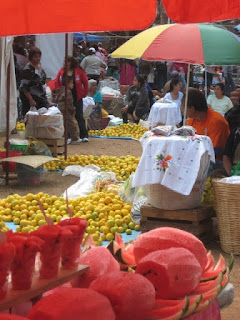The event was part of a week-long celebration commemorating the 446th anniversary of the death of Don Vasco de Quiroga in 1565. Don Vasco was the visionary Spanish bishop, jurist and protector of the Indians in this region of Mexico. Heavily influenced by Thomas More's 1515 book Utopia, he set about organizing indigenous communities here along Utopian principals, and his influence is still apparent today as villages retain craft specialties established hundreds of years ago.
Nancy was nursing an irritated throat last evening, so I walked the five minutes to the Templo del Sagrario, encountering my friend Bernard coming out of his house along the way. Begun in 1693 and completed 200 years later, it's probably the most photographed building in Pátzcuaro. The windowed wall, old stone and general gravitas speak of its history.
 |
| Templo del Sagrario on Lerín |
 |
| Sagrario from the stairs |
 | ||
| Sagrario seems cold and foreboding at night |
 |
| Despite the cold exterior, the alter is filled with light |
The church has the original wood parquet floors, simple wood pews, and is far less grandiose than the Basílica two blocks away.
When the program was handed out, we finally learned that this was not an instrumental ensemble, but rather a choral performance by a university choir from Morelia. Nine female and four male very accomplished university students filled the church with their voices. I used my little Motorola Droid as a monaural recorder to capture a very enjoyable performance. I've edited out the applause and general delays, but the audience was highly appreciative of their efforts. You can listen to it below:
Coro Universitario
Old Abraham Brown .... Benjamin Britten
Ave Verum ... W.A. Mozart
El Grillo ... Josquin Desprez
Aquella Tarde ... Ernesto Lecuona
El cañaveral ... Popular Peruana
Obwisana ... Folklor de Ghana
Alma Illanera ... Venezuaela
Intermission
Mi ciudad ... Guadalupe Trigo, arranger Jorge Cozatl
Métete Teté (children's song) ... Fco. Gavilondo Soler
La bamba ... Popular Veracruzana, arranger Manuel Torres
La Adelita ... Popular Mexicana
Morelia ... Jesús Carreño
Cielito lindo ... Quirino Mendoza, arranger Hernán Cortés
Encore
(Didn't catch the name)
 |
| The University Choir |
There were also a few pieces done by a choral workshop group, but they did not measure up to the quality of the university choir, so I'm not presenting them here.
The celebration for Don Vasco de Quiroga continues with a play on Saturday night, a dance performance by the Pátzcuaro Folklóric Group on Sunday (always colorful and spirited), and a concert by the Young Persons' Chamber Orchestra of Michoacán on Monday at the Basílica. The orchestra consists of the best young musicians in the state between the ages of 11 and 32.
All events are free and a continuing tribute to the tremendous government support for the arts in Mexico. What a difference from the slash-and-burn-the-arts wrecking crew currently at work in the U.S. Congress.























